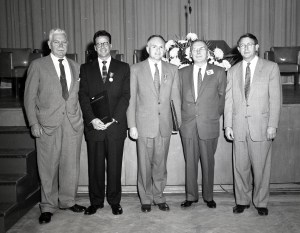
Researcher Seymour Lieblein receives a NACA Exceptional Service Award
National Advisory Committee for Aeronautics (NACA) Director of Research Hugh Dryden presents Seymour Lieblein with an Exceptional Service Award on October 28, 1957. Lieblein was hired at the NACA laboratory in Cleveland, Ohio shortly after earning a mechanical engineering degree from New York’s City College in 1944. During World War II he worked to resolve engine cooling issues for the B‒29 Superfortress. After the war, Lieblein was among a group of NACA researchers studying the design of axial-flow compressors for turbojet engines. There was a perceived limit to engine speed using the traditional design methods. By early 1950 Lieblein and his colleagues developed new blade shapes, advanced velocity diagram considerations, and improved blade loading principles. Lieblein created the “diffusion factor,” or D-factor, as a more reliable method for calculating the blade loads. The D-factor resulted in a reduction of compressor weight and manufacturing cost. Lieblein’s diffusion factor became the standard measure of compressor blade loading. General Electric first used the system on their J85 engine in the late 1950s. The Lewis group continued working on the transonic compressor problem by creating additional single-stage and multi-stage compressors and integrating them into advanced turbojet engines. They were able to demonstrate that there were no preexisting theoretical limitations to compressor design. Instead, performance could be continually increased with proper design methods. In 1955 the group published a top secret compressor design guide that was referred to as the “Compressor Bible”. The official name eventually became the “Aerodynamic Design of Axial-Flow Compressors.” Lieblein received a NACA Exceptional Service Award for this work in 1957.
- X



























